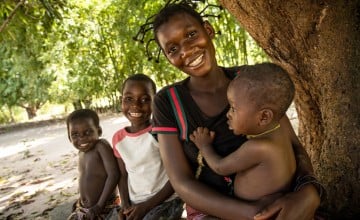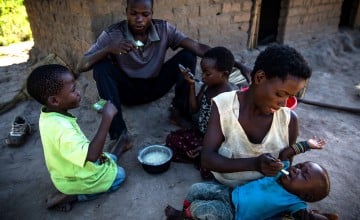
Knowledge Hub
Explained: The Sustainable Development Goals

In 2015, all United Member States made a commitment to strive for peace and prosperity for people and the planet, now and into the future. These promises were made in the form of the Sustainable Development Goals. But what are the Sustainable Development Goals, and how close are we to achieving them?
What are the Sustainable Development Goals?
The Sustainable Development Goals are a collection of 17 global goals adopted by all United Nations Member States. They are designed to be a "blueprint to achieve a better and more sustainable future for all".
What do the Sustainable Development Goals aim to tackle?
Set up in 2015, and anticipated to be achieved by 2030, these goals – to name a few – seek to realise human rights of all, achieve gender equality and empower all women and girls, eradicate poverty in all its forms everywhere and end world hunger.
How do the Sustainable Development Goals support international development?
The Sustainable Development Goals are an urgent call for action by all countries - developed and developing - in a global partnership.
“They recognise that ending poverty and other deprivations must go hand-in-hand with strategies that improve health and education, reduce inequality, and spur economic growth – all while tackling climate change and working to preserve our oceans and forests.” United Nations
What are the 17 Sustainable Development Goals?
The 17 Sustainable Goals are as follows:
- GOAL 1: No Poverty
- GOAL 2: Zero Hunger
- GOAL 3: Good Health and Well-being
- GOAL 4: Quality Education
- GOAL 5: Gender Equality
- GOAL 6: Clean Water and Sanitation
- GOAL 7: Affordable and Clean Energy
- GOAL 8: Decent Work and Economic Growth
- GOAL 9: Industry, Innovation and Infrastructure
- GOAL 10: Reduced Inequality
- GOAL 11: Sustainable Cities and Communities
- GOAL 12: Responsible Consumption and Production
- GOAL 13: Climate Action
- GOAL 14: Life Below Water
- GOAL 15: Life on Land
- GOAL 16: Peace and Justice Strong Institutions
- GOAL 17: Partnerships to achieve the Goal

Which Sustainable Development Goals do Concern focus on, and why?
Concern predominantly works towards achieving SDG1 and SDG2: No Poverty, and Zero Hunger. SDG2 is particularly critical as it underpins many of the other goals. There won’t be much improvement in people’s health or school performance without ensuring they have enough nutritious food to eat.
What is SDG1?
SDG1 aims to eradicate extreme poverty for all people everywhere, as well as build the resilience of vulnerable people and reduce their exposure to climate-related extreme events and other economic, social and environmental shocks and disasters. This is very much in line with our goals as an organisation which is to end extreme poverty, whatever it takes.
We also do lots of work in health and nutrition as our goal of ending extreme poverty can only be achieved by tackling poverty’s root causes – and top among them are poor public health and nutritional deficiencies.

What is SDG2?
SDG2 aims to end hunger and all forms of malnutrition, and ensure access by all people, in particular the poor and people in vulnerable situations, including infants, to safe, nutritious and sufficient food all year round.
Is the world on track to achieving the Sustainable Development Goals?
Despite progress over the last few decades – we saw a decline in the number of people living in extreme poverty from 36% in 1990 to 10% in 2015 – globally we are off track to meet the SDGs. World hunger levels have been rising since 2015 and since 2019, the pace of progress on extreme poverty has slowed, with the trend even reversing in 2020. This has been driven by the Covid-19 pandemic, inflation, recession, conflict and climate change.
Inequality is also increasing, both within and between countries. Although global poverty has now reduced to pre-pandemic levels, recovery has been uneven. Extreme poverty remains persistently high and even increasing in lower-income countries and fragile and conflict-affected countries.
UK cuts to aid funding since 2020 have resulted in the reduction of critical support to the world’s least developed countries. Funding for nutrition programmes, for instance, fell by more than 70% in 2021, compared to 2019. Programmes aimed at reaching those furthest behind – including women, girls and people with disabilities – were cut. It is critical that the UK should return its aid funding at least to the legally mandated level of 0.7% GNI. Poverty eradication must remain the purpose of UK aid, and we need the UK to rebuild its reputation as a nutrition champion.
We must continue to strengthen resilience among communities in developing countries and it is imperative that poverty eradication remains the purpose of UK aid, and we need the UK to remain a nutrition champion. Concern continues to respond to this global threat and is well-equipped to support those who are most vulnerable. Find out more about our response here.
Other ways to help
Donate now
Give a one-off, or a monthly, donation today.
Join an event
From mountain trekking to marathon running, join us for one of our many exciting outdoor events!
Buy a gift
With an extensive range of alternative gifts, we have something to suit everybody.
Leave a gift in your will
Leave the world a better place with a life-changing legacy.
Become a corporate supporter
We partner with a range of organisations that share our passion and the results have been fantastic.
Create your own fundraising event
Raise money for Concern by organising your own charity fundraising event.





